


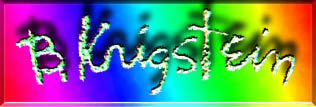
I think that there have been only three true geniuses in the field of comic books and, oddly enough, each of their names begin with the letter "K". Jack Kirby defined the form and the language of the comic book, creating the shorthand and conventions still in use (or still very much ignored) today. Harvey Kurtzman took the content of the comic book to new levels of both relevance and reality, and taught it how to really laugh, too. But it was Bernard Krigstein who saw the, as yet unrealized, potential of the medium and began to explore the notion of defining time and speed with the comic panels and the spaces between them.
Krigstein began working in comics in 1943 at the age of 24. This early foray was interrupted by military service, but he returned to the field in 1947. These early stories betray little of the deep exploration and understanding of the medium that was to follow.
At EC in the early 1950's, Krigstein worked with Kurtzman and the two geniuses were at complete loggerheads with each other. Kurtzman's meticulously laid-out storytelling conflicted on almost every level with Krigstein's experimentation with panel breakdown and the use of the panel to slow down or speed up the reading process. The relationship didn't last long and it was a very stormy one. It's too bad, because I've always imagined that an exploration of the medium by these two in collaboration could and should have been awesome.
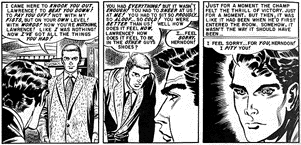 Even more
contentious was the interaction of Krigstein and Al Feldstein,
for whom he did most of his EC work. Feldstein was a "writer"
and the words were everything (see the three panels at left for
an example). To Krigstein, the image was the tool of the comic
book and its fragmentations and repetition was the language. Words
were secondary, especially those that described what could be
drawn. Again, conflict was the name of the game and it's amazing
that some of his most magnificent work was actually accomplished
at EC.
Even more
contentious was the interaction of Krigstein and Al Feldstein,
for whom he did most of his EC work. Feldstein was a "writer"
and the words were everything (see the three panels at left for
an example). To Krigstein, the image was the tool of the comic
book and its fragmentations and repetition was the language. Words
were secondary, especially those that described what could be
drawn. Again, conflict was the name of the game and it's amazing
that some of his most magnificent work was actually accomplished
at EC.
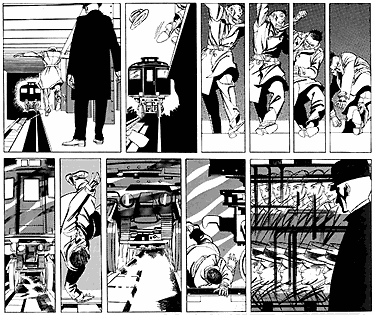
The oft-reprinted wordless sequence above is from Krigstein's one chance at EC to tell a story his way. It's from Impact #1 (Mar-Apr 1955) and is the denouement of "Master Race", his masterpiece. Krigstein convinced Feldstein (and Bill Gaines, the publisher) to let him take Feldstein's script and break it down into pages and panels as he saw fit. What resulted can only be described as stunning innovation and it is to the everlasting discredit of the EC principals that the first example I showed above is from Impact #5! Five issues after "Master Race", no one at EC had gotten the message!
These samples and virtually all of Krigstein's EC work are to be found in Russ Cochran's glorious b&w reprint series of boxed hardbound books.
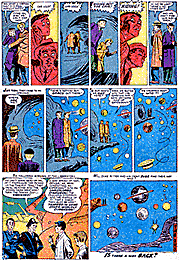 After
EC, Krigstein continued his exploration of the limits of the medium
at Atlas Comics (which would later become Marvel). What he lacked
in script quality (and sensitive coloring) was offset by a complete and utter freedom to
do as he pleased. A random page is at right. And I do mean random
- I picked the first book I found on my list of Atlas Krigstein
stories and this is what I found. The drawing became more and
more sketchy and his effort was applied to the breakdown and experiments
rather than rendering. I seem to recall a number like 33 being
the largest number of panels on a single page during this time
(1956-57), but I wasn't going to search through the literally
hundred or so stories he did there to find it.
After
EC, Krigstein continued his exploration of the limits of the medium
at Atlas Comics (which would later become Marvel). What he lacked
in script quality (and sensitive coloring) was offset by a complete and utter freedom to
do as he pleased. A random page is at right. And I do mean random
- I picked the first book I found on my list of Atlas Krigstein
stories and this is what I found. The drawing became more and
more sketchy and his effort was applied to the breakdown and experiments
rather than rendering. I seem to recall a number like 33 being
the largest number of panels on a single page during this time
(1956-57), but I wasn't going to search through the literally
hundred or so stories he did there to find it.

It was during this period that he expanded his market to books. Real books. In 1955 he brought his knowledge of action and art to the service of a book on baseball. How to Play Baseball by M.G. Bonner took his skills to their logical conclusion. The fluid motion and his solid knowledge of the way the human body worked combined with the opportunity for a multiplicity of movements in service to an instructional text was perfect for Bernie. There were no others, sadly, but this was a gem, as you can see from the example on pitching above.
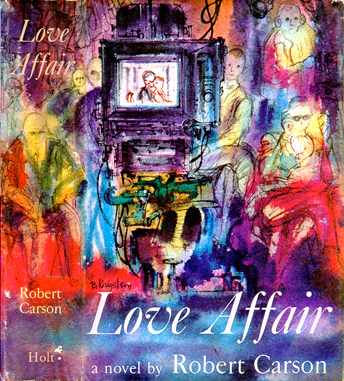
As he was weaning himself from comics (and comics were becoming less rewarding), he moved more and more into mainstream book illustration and teaching. Abortive attempts at starting an artist's union had left him disenchanted with his fellows and with the industry. The lure of art with a capital A, watercolors, oils, experimentation with no restrictions and the financial security of commercial art and a secure teaching position were the death knell of a comic style that almost never was.
Love Affair, from 1958 above, shows Krigstein's "commercial" side, as do the quartet of titles below.
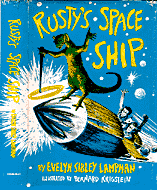
|
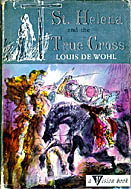
|
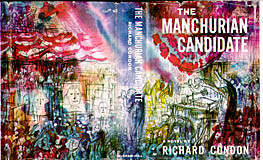 |
 |
|
Rusty's Space Ship 1957 |
St Helena and the True Cross 1958 |
The Manchurian Candidate 1959 |
Buccaneers & Pirates of Our Coasts 1960 |
 He
did many interior illustrations for most of these books. Many
were done in a simple, yet powerful combination of parallel line
zip-a-tone and wash or occasional color. At left is a tiny sample
from the cover of a Mormon Tabernacle Choir LP entitled Songs
of the North & South 1861-1865. Computer screens and zip-a-tone
don't go together very well, so I've done a bit of retouching
so as to convey Krigstein's approach more clearly.
He
did many interior illustrations for most of these books. Many
were done in a simple, yet powerful combination of parallel line
zip-a-tone and wash or occasional color. At left is a tiny sample
from the cover of a Mormon Tabernacle Choir LP entitled Songs
of the North & South 1861-1865. Computer screens and zip-a-tone
don't go together very well, so I've done a bit of retouching
so as to convey Krigstein's approach more clearly.
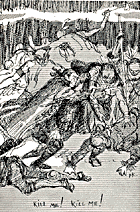 He
used the same techniques, often with multiple layering, over a
very free sketchy pen and ink style that he adopted for many of
these books. At right is a very small version of a full-page drawing
from The Flagship Hope: Aaron Lopez by Lloyd Alexander
from 1960. These and many other simple but powerful techniques
were adopted from the shading he used in his comic work (both
pen and mechanical as can be seen in the two b&w comic sequences
above).
He
used the same techniques, often with multiple layering, over a
very free sketchy pen and ink style that he adopted for many of
these books. At right is a very small version of a full-page drawing
from The Flagship Hope: Aaron Lopez by Lloyd Alexander
from 1960. These and many other simple but powerful techniques
were adopted from the shading he used in his comic work (both
pen and mechanical as can be seen in the two b&w comic sequences
above).
Fine art was his final calling and after a few more side trips into magazine and text book illustration, and even one last 1962 comic book job, he spent the remainder of his life painting the things that he wanted to paint and that brought him joy. I hope that someday a definitive book on Krigstein will be published. Then the world will see a many-faceted artist who could have raised the comic book medium to an artistic level that has never and probably will never be attained. We're left with some very tantalizing glimpses of what might have been....
 To find out more about Bernie Krigstein, see:
To find out more about Bernie Krigstein, see:
| The Who's Who of American Comic Books | Jerry Bails & Hames Ware, 1998 |
| B. Krigstein | Greg Sadowski, 2002 Fantagraphics |
| The Vadeboncoeur Collection of Knowledge | Jim Vadeboncoeur, Jr., 1998 |
| Several people have asked about The Vadeboncoeur Collection of Knowledge and its availability. I've been a collector for forty-tum-te-tum years and my home is a repository for an amazing amount of reference material. It is this accumulation that I draw upon to write these essays and it is this accumulation that I am referring to when I mention this source. It's always available for viewing and for personal research - just ask. |
|
Illustrations copyright by their respective
owners and used here for educational purposes only. This page written, designed & © 1998 by Jim Vadeboncoeur, Jr. Updated 2011. |
